warning FIAT TALENTO 2018 Owner handbook (in English)
[x] Cancel search | Manufacturer: FIAT, Model Year: 2018, Model line: TALENTO, Model: FIAT TALENTO 2018Pages: 232, PDF Size: 5.54 MB
Page 172 of 232
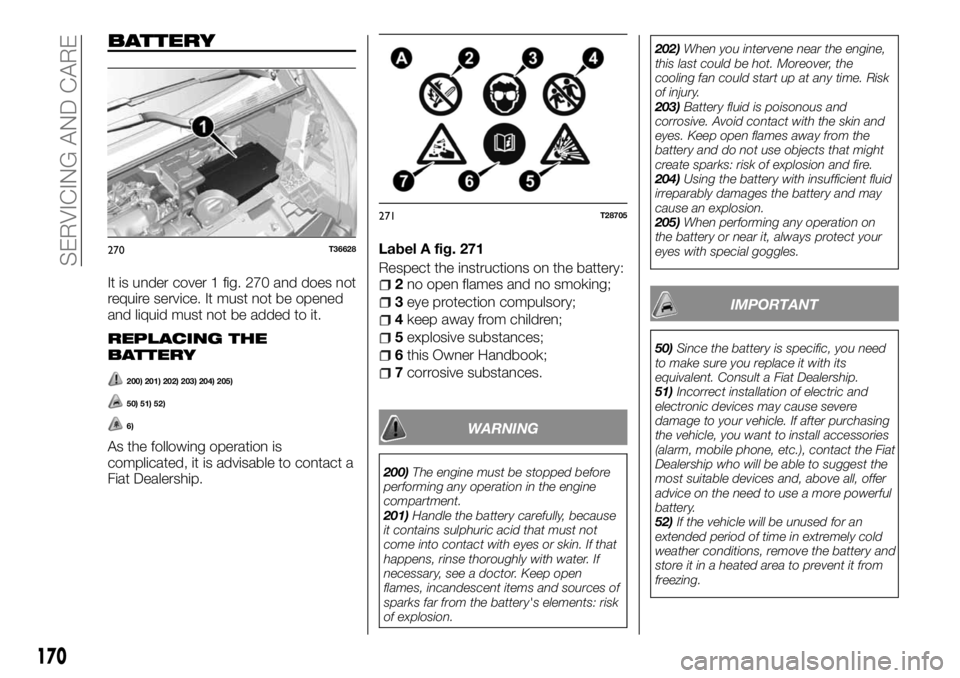
BATTERY
It is under cover 1 fig. 270 and does not
require service. It must not be opened
and liquid must not be added to it.
REPLACING THE
BATTERY
200) 201) 202) 203) 204) 205)
50) 51) 52)
6)
As the following operation is
complicated, it is advisable to contact a
Fiat Dealership.Label A fig. 271
Respect the instructions on the battery:
2no open flames and no smoking;
3eye protection compulsory;
4keep away from children;
5explosive substances;
6this Owner Handbook;
7corrosive substances.
WARNING
200)The engine must be stopped before
performing any operation in the engine
compartment.
201)Handle the battery carefully, because
it contains sulphuric acid that must not
come into contact with eyes or skin. If that
happens, rinse thoroughly with water. If
necessary, see a doctor. Keep open
flames, incandescent items and sources of
sparks far from the battery's elements: risk
of explosion.202)When you intervene near the engine,
this last could be hot. Moreover, the
cooling fan could start up at any time. Risk
of injury.
203)Battery fluid is poisonous and
corrosive. Avoid contact with the skin and
eyes. Keep open flames away from the
battery and do not use objects that might
create sparks: risk of explosion and fire.
204)Using the battery with insufficient fluid
irreparably damages the battery and may
cause an explosion.
205)When performing any operation on
the battery or near it, always protect your
eyes with special goggles.
IMPORTANT
50)Since the battery is specific, you need
to make sure you replace it with its
equivalent. Consult a Fiat Dealership.
51)Incorrect installation of electric and
electronic devices may cause severe
damage to your vehicle. If after purchasing
the vehicle, you want to install accessories
(alarm, mobile phone, etc.), contact the Fiat
Dealership who will be able to suggest the
most suitable devices and, above all, offer
advice on the need to use a more powerful
battery.
52)If the vehicle will be unused for an
extended period of time in extremely cold
weather conditions, remove the battery and
store it in a heated area to prevent it from
freezing.
270T36628
271T28705
170
SERVICING AND CARE
Page 173 of 232
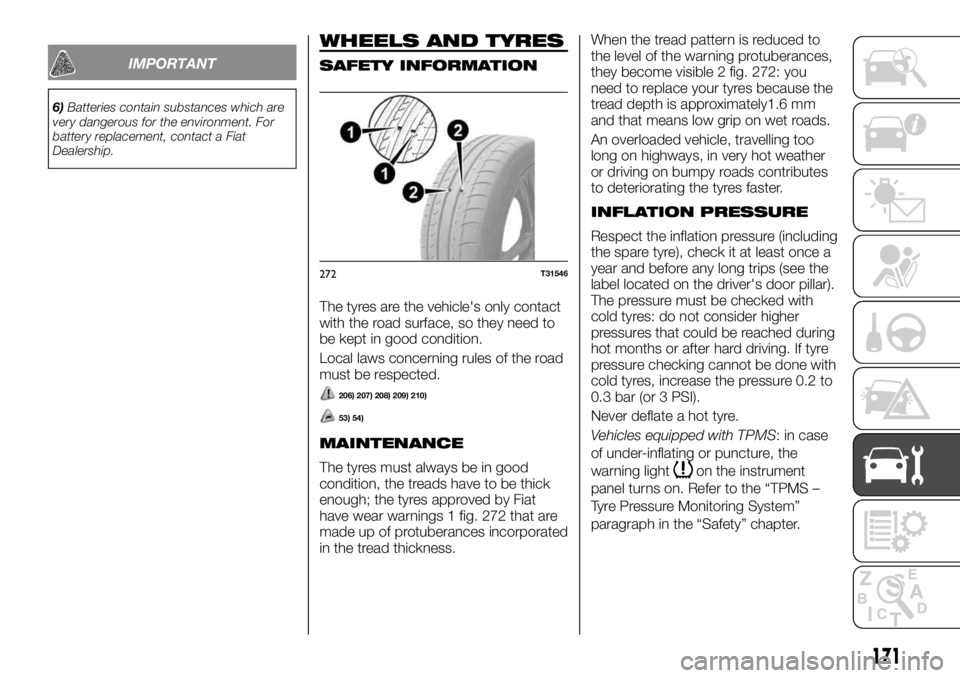
IMPORTANT
6)Batteries contain substances which are
very dangerous for the environment. For
battery replacement, contact a Fiat
Dealership.
WHEELS AND TYRES
SAFETY INFORMATION
The tyres are the vehicle's only contact
with the road surface, so they need to
be kept in good condition.
Local laws concerning rules of the road
must be respected.
206) 207) 208) 209) 210)
53) 54)
MAINTENANCE
The tyres must always be in good
condition, the treads have to be thick
enough; the tyres approved by Fiat
have wear warnings 1 fig. 272 that are
made up of protuberances incorporated
in the tread thickness.When the tread pattern is reduced to
the level of the warning protuberances,
they become visible 2 fig. 272: you
need to replace your tyres because the
tread depth is approximately1.6 mm
and that means low grip on wet roads.
An overloaded vehicle, travelling too
long on highways, in very hot weather
or driving on bumpy roads contributes
to deteriorating the tyres faster.
INFLATION PRESSURE
Respect the inflation pressure (including
the spare tyre), check it at least once a
year and before any long trips (see the
label located on the driver's door pillar).
The pressure must be checked with
cold tyres: do not consider higher
pressures that could be reached during
hot months or after hard driving. If tyre
pressure checking cannot be done with
cold tyres, increase the pressure 0.2 to
0.3 bar (or 3 PSI).
Never deflate a hot tyre.
Vehicles equipped with TPMS: in case
of under-inflating or puncture, the
warning light
on the instrument
panel turns on. Refer to the “TPMS –
Tyre Pressure Monitoring System”
paragraph in the “Safety” chapter.
272T31546
171
Page 174 of 232

Label A fig. 274
To read it open the driver's door
fig. 275.
B: front tyre inflation pressure when
not driving on a highway, or when there
are fewer than four people on board.
C: rear tyre pressure inflation when
not driving on a highway, or when there
are fewer than four people on board.
D: pressure inflation for front tyres
when travelling on a highway or when
there is a significant load.
E: pressure inflation for rear tyres
when travelling on a highway or when
there is a significant load.
IMPORTANT For cars used at full load
(Maximum Authorised Mass) and with a
tow trailer, the maximum speed must
not exceed 100 km/h and the tyre
pressure must be increased by 0.2 bar.
Refer to the “Weights” paragraph on
the “Technical data” chapter.Risk of
tyres bursting.
SPARE TYRE
Please see the paragraph "Replacing a
tyre" in the "Emergency" chapter.
SUGGESTIONS ABOUT
THE ROTATION OF THE
TYRES
We advise you not to do this kind of
operation.
WINTER USE
55) 56) 57) 58)
Chains
For safety reasons, mounting snow
chains on the rear axle is prohibited.
The use of larger sized tyres than the
original ones makes fitting chains
impossible.Snow tyres
We advise you to fit these tyres to
guarantee the best vehicle grip
possible.
IMPORTANT These tyres sometimes
mean a maximum speed limit that may
be less than vehicle’s maximum speed.
Studded tyres
(For versions/markets where provided)
This type of tyre can only be used for a
limited period determined by local laws.
You need to respect the speed limits
imposed by local laws in effect.
These tyres can be fitted on at least
both front wheels.
In any case, it is advisable to
contact a Fiat Dealership.
WARNING
206)Insufficient pressure can cause the
tyres to wear early and heat up abnormally,
with obvious consequences for safety;
poor road grip, risk of blow-out or treads
detaching. Inflation pressure depends on
the load and the speed. Adjust the
pressure according to the conditions of
use (see the label located on the inside of
the driver's door pillar).
207)For safety reasons, only a specialised
technician should carry out this operation.
Fitting a different type of tyre can alter the
vehicle's compliance with the regulations in
force, cornering performance, steering and
fitting snow chains.
274T36619
275T36615
172
SERVICING AND CARE
Page 178 of 232
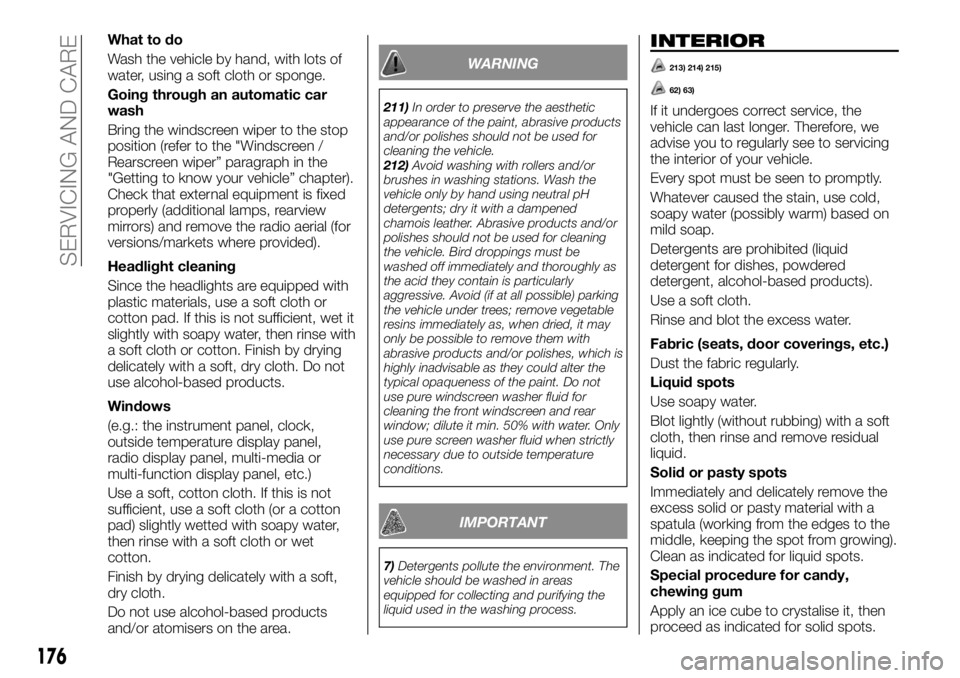
What to do
Wash the vehicle by hand, with lots of
water, using a soft cloth or sponge.
Going through an automatic car
wash
Bring the windscreen wiper to the stop
position (refer to the "Windscreen /
Rearscreen wiper” paragraph in the
"Getting to know your vehicle” chapter).
Check that external equipment is fixed
properly (additional lamps, rearview
mirrors) and remove the radio aerial (for
versions/markets where provided).
Headlight cleaning
Since the headlights are equipped with
plastic materials, use a soft cloth or
cotton pad. If this is not sufficient, wet it
slightly with soapy water, then rinse with
a soft cloth or cotton. Finish by drying
delicately with a soft, dry cloth. Do not
use alcohol-based products.
Windows
(e.g.: the instrument panel, clock,
outside temperature display panel,
radio display panel, multi-media or
multi-function display panel, etc.)
Use a soft, cotton cloth. If this is not
sufficient, use a soft cloth (or a cotton
pad) slightly wetted with soapy water,
then rinse with a soft cloth or wet
cotton.
Finish by drying delicately with a soft,
dry cloth.
Do not use alcohol-based products
and/or atomisers on the area.
WARNING
211)In order to preserve the aesthetic
appearance of the paint, abrasive products
and/or polishes should not be used for
cleaning the vehicle.
212)Avoid washing with rollers and/or
brushes in washing stations. Wash the
vehicle only by hand using neutral pH
detergents; dry it with a dampened
chamois leather. Abrasive products and/or
polishes should not be used for cleaning
the vehicle. Bird droppings must be
washed off immediately and thoroughly as
the acid they contain is particularly
aggressive. Avoid (if at all possible) parking
the vehicle under trees; remove vegetable
resins immediately as, when dried, it may
only be possible to remove them with
abrasive products and/or polishes, which is
highly inadvisable as they could alter the
typical opaqueness of the paint. Do not
use pure windscreen washer fluid for
cleaning the front windscreen and rear
window; dilute it min. 50% with water. Only
use pure screen washer fluid when strictly
necessary due to outside temperature
conditions.
IMPORTANT
7)Detergents pollute the environment. The
vehicle should be washed in areas
equipped for collecting and purifying the
liquid used in the washing process.
INTERIOR
213) 214) 215)
62) 63)
If it undergoes correct service, the
vehicle can last longer. Therefore, we
advise you to regularly see to servicing
the interior of your vehicle.
Every spot must be seen to promptly.
Whatever caused the stain, use cold,
soapy water (possibly warm) based on
mild soap.
Detergents are prohibited (liquid
detergent for dishes, powdered
detergent, alcohol-based products).
Use a soft cloth.
Rinse and blot the excess water.
Fabric (seats, door coverings, etc.)
Dust the fabric regularly.
Liquid spots
Use soapy water.
Blot lightly (without rubbing) with a soft
cloth, then rinse and remove residual
liquid.
Solid or pasty spots
Immediately and delicately remove the
excess solid or pasty material with a
spatula (working from the edges to the
middle, keeping the spot from growing).
Clean as indicated for liquid spots.
Special procedure for candy,
chewing gum
Apply an ice cube to crystalise it, then
proceed as indicated for solid spots.
176
SERVICING AND CARE
Page 179 of 232
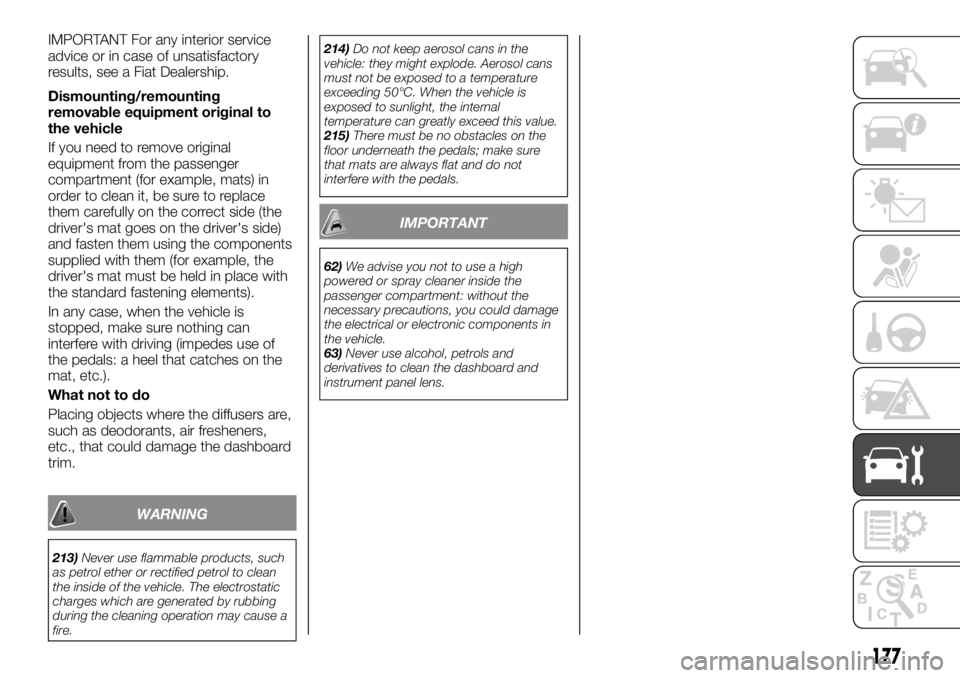
IMPORTANT For any interior service
advice or in case of unsatisfactory
results, see a Fiat Dealership.
Dismounting/remounting
removable equipment original to
the vehicle
If you need to remove original
equipment from the passenger
compartment (for example, mats) in
order to clean it, be sure to replace
them carefully on the correct side (the
driver's mat goes on the driver's side)
and fasten them using the components
supplied with them (for example, the
driver's mat must be held in place with
the standard fastening elements).
In any case, when the vehicle is
stopped, make sure nothing can
interfere with driving (impedes use of
the pedals: a heel that catches on the
mat, etc.).
What not to do
Placing objects where the diffusers are,
such as deodorants, air fresheners,
etc., that could damage the dashboard
trim.
WARNING
213)Never use flammable products, such
as petrol ether or rectified petrol to clean
the inside of the vehicle. The electrostatic
charges which are generated by rubbing
during the cleaning operation may cause a
fire.214)Do not keep aerosol cans in the
vehicle: they might explode. Aerosol cans
must not be exposed to a temperature
exceeding 50°C. When the vehicle is
exposed to sunlight, the internal
temperature can greatly exceed this value.
215)There must be no obstacles on the
floor underneath the pedals; make sure
that mats are always flat and do not
interfere with the pedals.
IMPORTANT
62)We advise you not to use a high
powered or spray cleaner inside the
passenger compartment: without the
necessary precautions, you could damage
the electrical or electronic components in
the vehicle.
63)Never use alcohol, petrols and
derivatives to clean the dashboard and
instrument panel lens.
177
Page 183 of 232

Multijet 95 Ecojet 95 Multijet 120 Ecojet 125 Ecojet 145
EMISSION LEVEL Euro 6
ENGINE
Engine
typeR9M
Engine displacement (cm³) 1598
Type of injection Common rail turbo Common rail turbo Common rail turboCommon rail twin
turboCommon rail twin
turbo
Type of fuelDiesel
Start&Stop – Standard – Standard Standard
Number of cylinders 4 in line
Number of valves 16
Bore/stroke ratio (at rpm) 80/79.5
Particulate filter SCR catalytic converter and injection Adblue with particulate filter (DPF)
Compression ratio 15.45:1
Maximum engine power70 KW (95 HP) at
3500 rpm70 KW (95 HP) at
3500 rpm88 KW (120 HP) at
3500 rpm92 KW (125 HP) at
3500 rpm107 KW (145 HP)
at 3500 rpm
Maximum torque260 Nm at
1500 rpm260 Nm at
1500 rpm300 Nm at
1500 rpm320 Nm at
1500 rpm340 Nm at
1500 rpm
Tank capacity (litres) 80
Type of fuel The tag on the fuel tank flap indicates the authorised fuel.
WARNING
216)Modifications or repairs to the supply system that are not carried out correctly or do not take the system technical specifications into
account can cause malfunctions leading to the risk of fire.
181
Page 210 of 232
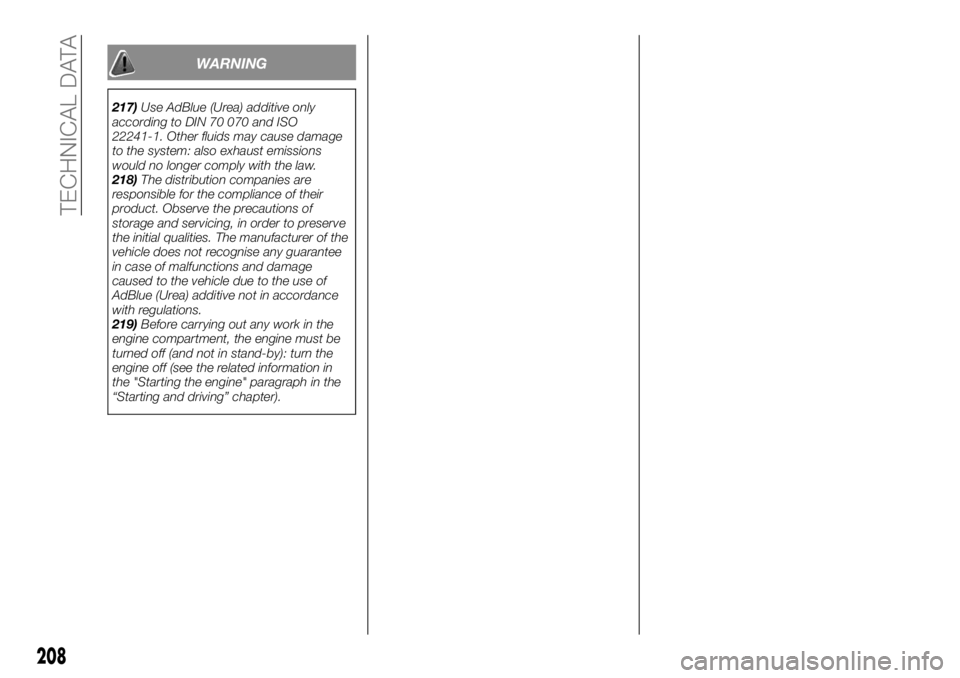
WARNING
217)Use AdBlue (Urea) additive only
according to DIN 70 070 and ISO
22241-1. Other fluids may cause damage
to the system: also exhaust emissions
would no longer comply with the law.
218)The distribution companies are
responsible for the compliance of their
product. Observe the precautions of
storage and servicing, in order to preserve
the initial qualities. The manufacturer of the
vehicle does not recognise any guarantee
in case of malfunctions and damage
caused to the vehicle due to the use of
AdBlue (Urea) additive not in accordance
with regulations.
219)Before carrying out any work in the
engine compartment, the engine must be
turned off (and not in stand-by): turn the
engine off (see the related information in
the "Starting the engine" paragraph in the
“Starting and driving” chapter).
208
TECHNICAL DATA
Page 220 of 232
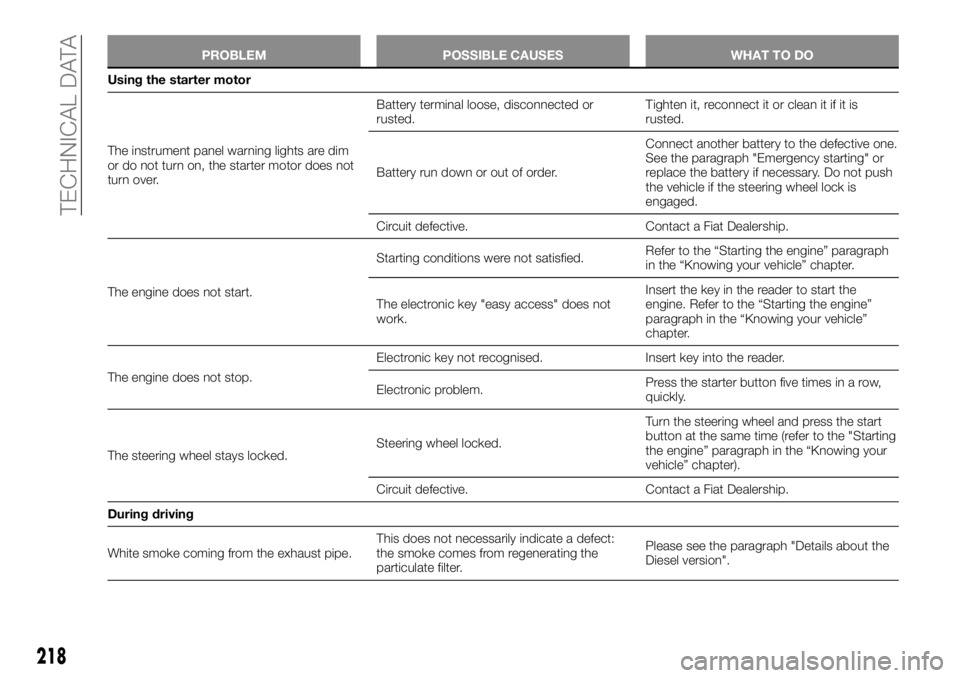
PROBLEM POSSIBLE CAUSES WHAT TO DO
Using the starter motor
The instrument panel warning lights are dim
or do not turn on, the starter motor does not
turn over.Battery terminal loose, disconnected or
rusted.Tighten it, reconnect it or clean it if it is
rusted.
Battery run down or out of order.Connect another battery to the defective one.
See the paragraph "Emergency starting" or
replace the battery if necessary. Do not push
the vehicle if the steering wheel lock is
engaged.
Circuit defective. Contact a Fiat Dealership.
The engine does not start.Starting conditions were not satisfied.Refer to the “Starting the engine” paragraph
in the “Knowing your vehicle” chapter.
The electronic key "easy access" does not
work.Insert the key in the reader to start the
engine. Refer to the “Starting the engine”
paragraph in the “Knowing your vehicle”
chapter.
The engine does not stop.Electronic key not recognised. Insert key into the reader.
Electronic problem.Press the starter button five times in a row,
quickly.
The steering wheel stays locked.Steering wheel locked.Turn the steering wheel and press the start
button at the same time (refer to the "Starting
the engine” paragraph in the “Knowing your
vehicle” chapter).
Circuit defective. Contact a Fiat Dealership.
During driving
White smoke coming from the exhaust pipe.This does not necessarily indicate a defect:
the smoke comes from regenerating the
particulate filter.Please see the paragraph "Details about the
Diesel version".
218
TECHNICAL DATA
Page 221 of 232
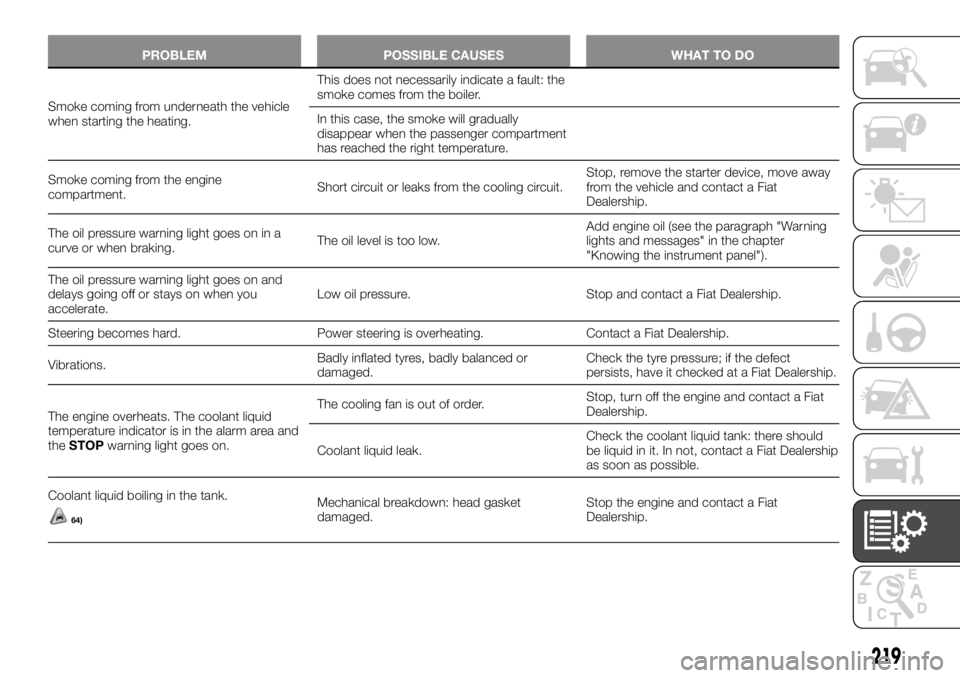
PROBLEM POSSIBLE CAUSES WHAT TO DO
Smoke coming from underneath the vehicle
when starting the heating.This does not necessarily indicate a fault: the
smoke comes from the boiler.
In this case, the smoke will gradually
disappear when the passenger compartment
has reached the right temperature.
Smoke coming from the engine
compartment.Short circuit or leaks from the cooling circuit.Stop, remove the starter device, move away
from the vehicle and contact a Fiat
Dealership.
The oil pressure warning light goes on in a
curve or when braking.The oil level is too low.Add engine oil (see the paragraph "Warning
lights and messages" in the chapter
"Knowing the instrument panel").
The oil pressure warning light goes on and
delays going off or stays on when you
accelerate.Low oil pressure. Stop and contact a Fiat Dealership.
Steering becomes hard. Power steering is overheating. Contact a Fiat Dealership.
Vibrations.Badly inflated tyres, badly balanced or
damaged.Check the tyre pressure; if the defect
persists, have it checked at a Fiat Dealership.
The engine overheats. The coolant liquid
temperature indicator is in the alarm area and
theSTOPwarning light goes on.The cooling fan is out of order.Stop, turn off the engine and contact a Fiat
Dealership.
Coolant liquid leak.Check the coolant liquid tank: there should
be liquid in it. In not, contact a Fiat Dealership
as soon as possible.
Coolant liquid boiling in the tank.
64)
Mechanical breakdown: head gasket
damaged.Stop the engine and contact a Fiat
Dealership.
219
Page 222 of 232
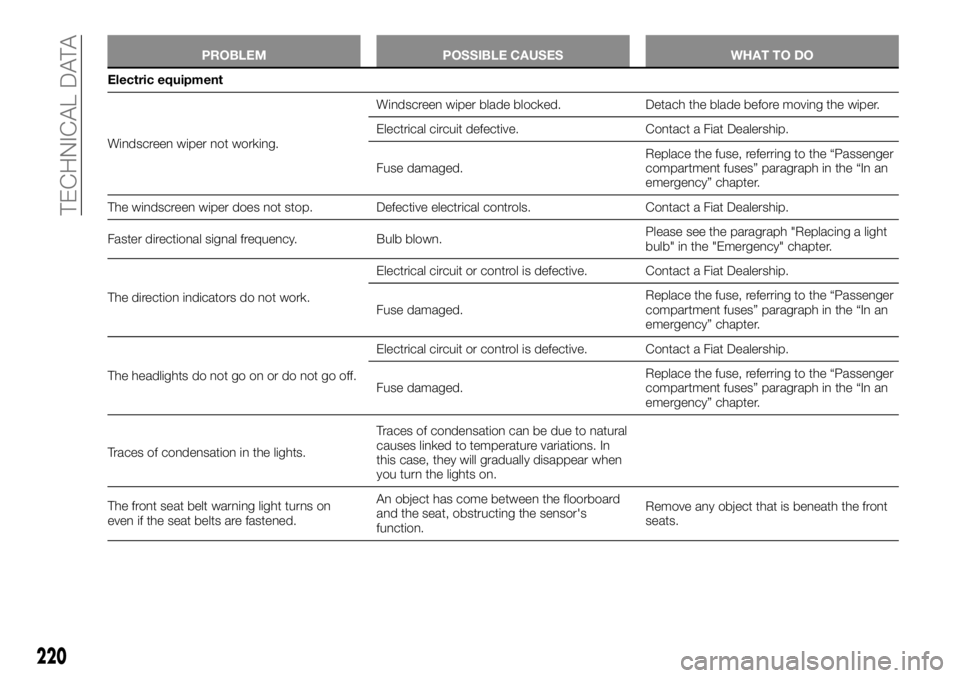
PROBLEM POSSIBLE CAUSES WHAT TO DO
Electric equipment
Windscreen wiper not working.Windscreen wiper blade blocked. Detach the blade before moving the wiper.
Electrical circuit defective. Contact a Fiat Dealership.
Fuse damaged.Replace the fuse, referring to the “Passenger
compartment fuses” paragraph in the “In an
emergency” chapter.
The windscreen wiper does not stop. Defective electrical controls. Contact a Fiat Dealership.
Faster directional signal frequency. Bulb blown.Please see the paragraph "Replacing a light
bulb" in the "Emergency" chapter.
The direction indicators do not work.Electrical circuit or control is defective. Contact a Fiat Dealership.
Fuse damaged.Replace the fuse, referring to the “Passenger
compartment fuses” paragraph in the “In an
emergency” chapter.
The headlights do not go on or do not go off.Electrical circuit or control is defective. Contact a Fiat Dealership.
Fuse damaged.Replace the fuse, referring to the “Passenger
compartment fuses” paragraph in the “In an
emergency” chapter.
Traces of condensation in the lights.Traces of condensation can be due to natural
causes linked to temperature variations. In
this case, they will gradually disappear when
you turn the lights on.
The front seat belt warning light turns on
even if the seat belts are fastened.An object has come between the floorboard
and the seat, obstructing the sensor's
function.Remove any object that is beneath the front
seats.
220
TECHNICAL DATA